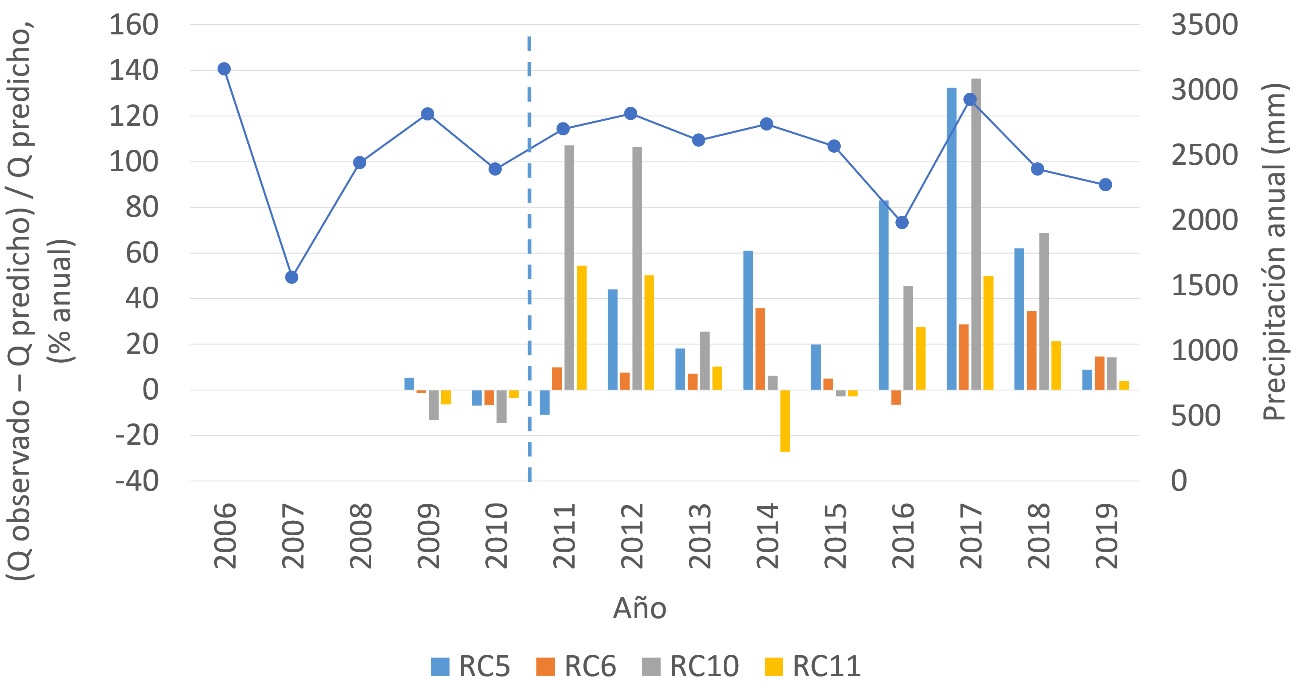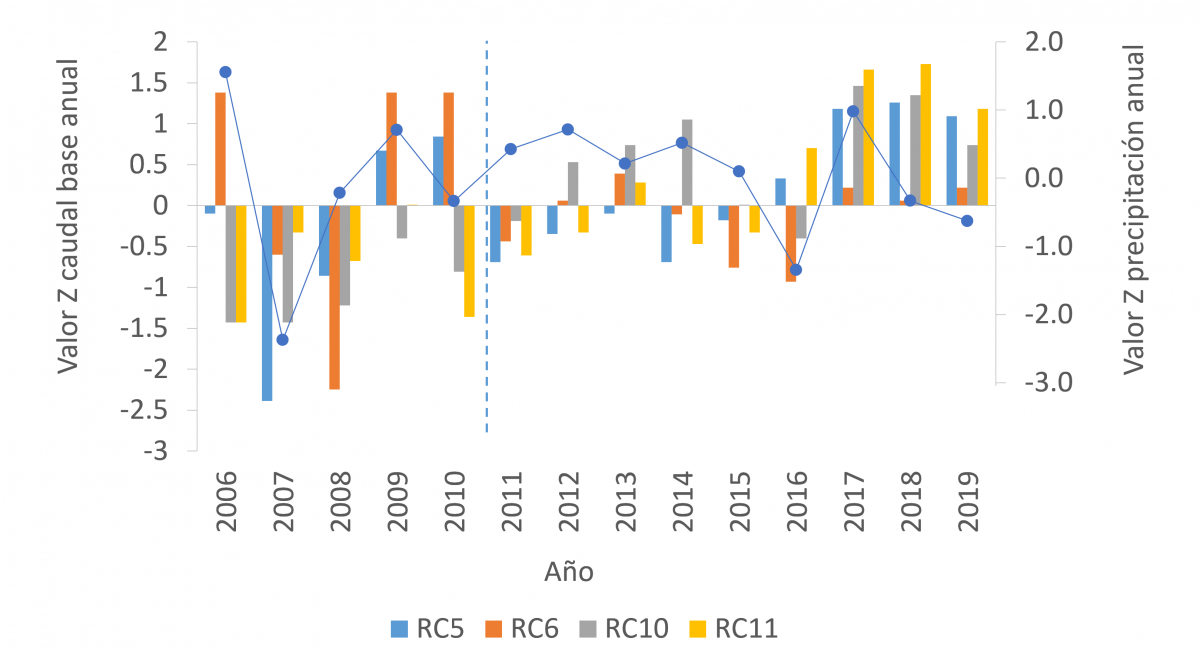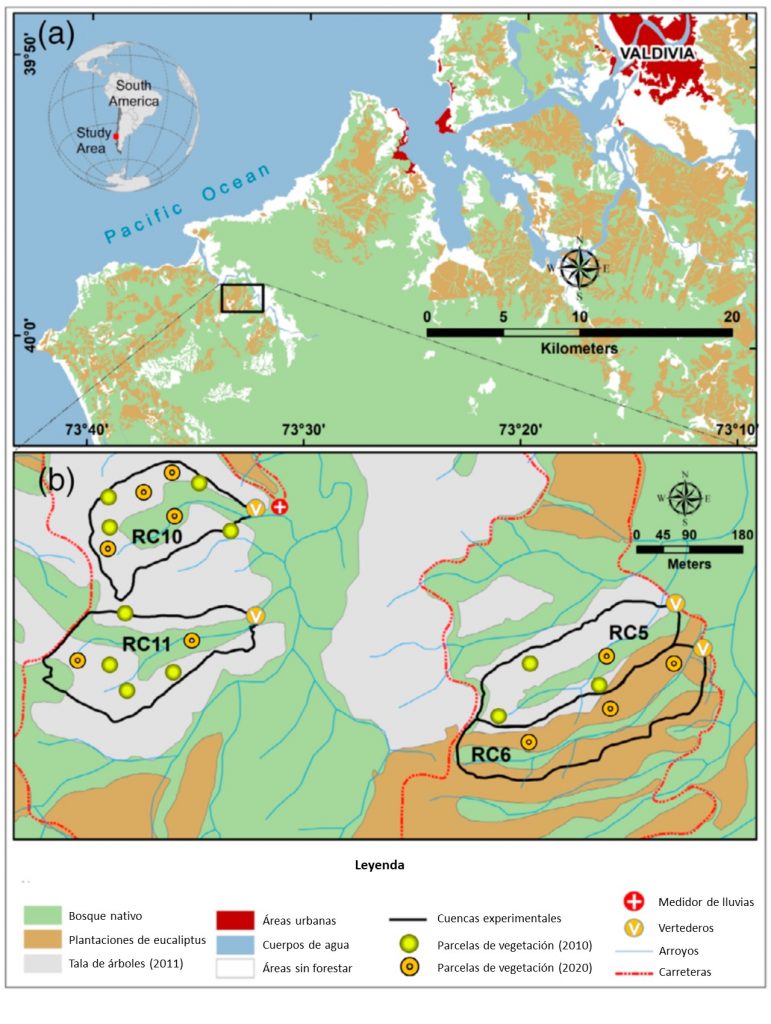- After 14 years of research, it was shown that recovering areas with native vegetation generates an increase in flows immediately and its maintenance over time.
- This result is relevant when considering the projected drought scenarios for the next few years due to climate change.
- This study is the first to document the response of flows in restored watersheds that were previously industrial forest plantations of exotic species.
By Antonio Lara1,2,3, Julia Jones4, Christian Little5 and Nicolás Vergara1,2
Many hectares of native forest in the south-central zone of Chile have been replaced by exotic plantations of pine (Pinus radiata) and eucalyptus (Eucalyptus globulus, E. nitens), in addition to shrubs, grasslands, or agricultural land. Different studies have associated these changes with negative impacts on ecosystems, such as a decrease in the water supply of basins, a reduction in biodiversity, and a lower carbon storage capacity.
Just as this replacement generates negative impacts, a study published in the journal Hydrological Processes considered the effect that the restoration of native forests would have on water, focusing on the flow of streams and soil moisture.
A 14-year investigation [1] (2006 to 2019) was carried out in the Valdivian Coastal Reserve, located in the south-central zone of Chile (Figure 1a), which was formerly a property of a forestry company. Between 64% and 76% of the vegetation was eucalyptus trees, and between 24% and 36% was a native forest.
With the idea of having greater representativeness, the study area was divided into four basins (Figure 1b). Furthermore, the flow measurements, carried out every 15 minutes with specialized instruments, were separated into two periods: (a) from 2006 to 2011 and (b) from 2011 to 2019. This was due to the fact that in 2011 Eucalyptus trees were felled in three of the basins, and coihue (Nothofagus dombeyi) was planted in them. They were fenced off and protected from livestock in order to promote the natural regeneration process of other native species. Meanwhile, a control basin was maintained with eucalyptus. Thanks to this, it was possible to compare the flows of restored basins versus an unrestored ones.
Figure 1. Study site. Panel (a) shows the location of the Valdivian Coastal Reserve, on the coast of the south-central zone of Chile, southwest of the city of Valdivia. Panel (b) shows the four basins studied, called RC5, RC6, RC10, and RC11. Source: Modified from Lara et al. (2021).
Results
The research indicated that in most of the years after 2011, when the restoration began, the annual flow of the streams increased between 40% and 130% in the three restored basins, mainly in winter, followed by fall, spring, and summer (Figure 2).
 Figure 2. The colored bars represent the flow (in millimeters) in each of the study basins. The vertical dotted line represents the felling of the eucalyptus trees between January and April 2011. You can see the increase in flows from that year onwards. The horizontal line represents (at a percentage level) the difference between the observed flow and the one predicted from the rainfall in the period 2009-2011. Source: Modified from Lara et al. (2021).
Figure 2. The colored bars represent the flow (in millimeters) in each of the study basins. The vertical dotted line represents the felling of the eucalyptus trees between January and April 2011. You can see the increase in flows from that year onwards. The horizontal line represents (at a percentage level) the difference between the observed flow and the one predicted from the rainfall in the period 2009-2011. Source: Modified from Lara et al. (2021).
During the years with low rainfall, the basins restored with native forest maintained some water availability. This can be explained due to the potential of native vegetation to retain soil moisture, which would support the flow in rivers and streams during periods without rainfall, even for weeks or months, as occurs in summer. This constant flow is called base flow (figure 3). However, the increase in base flow was only appreciated six and eight years after the eucalyptus trees were felled, which is probably explained by the high evapotranspiration rates of this exotic species and the consequent depletion of water reserves on the soils.
 Figure 3. Variation of annual base flows (bars) and precipitation (line), both expressed as standardized deviations. The vertical segmented line shows the clearcut of the eucalyptus plantation and the beginning of the restoration in 2011. It can be seen that the base flow began to increase from the year 2017 onwards, which would mean that the water content started to recover in the ground. Source: Modified from Lara et al. (2021).
Figure 3. Variation of annual base flows (bars) and precipitation (line), both expressed as standardized deviations. The vertical segmented line shows the clearcut of the eucalyptus plantation and the beginning of the restoration in 2011. It can be seen that the base flow began to increase from the year 2017 onwards, which would mean that the water content started to recover in the ground. Source: Modified from Lara et al. (2021).
It is striking that the control basin that maintained the eucalyptus cover (RC6) also presented an increase in its flows. This can be explained for different reasons: The roads and pathways present in the RC5 basin (adjacent) may have diverted the precipitation to the control basin. Other factors may be the geological differences between the two or the contribution of rainfall by interception of fog in the RC6 basin.
These findings show, mainly, that the removal of eucalyptus plantations and the restoration with native forest immediately increases the flow of streams and the gradual recovery of the flows that feed on the water contained in the soil and the water table.
Forest restoration is key to the recovery of the ecosystem service of water provision in the basins and the regulation of flows, especially considering the drought trend of climate change projected in the center-south of our country for the next few years.
Recommendations
Taking into account all of the above, we recommend:
- Increase efforts to restore the native forest, especially considering the drought trend associated with climate change.
- Maintain and strengthen long-term study sites in Chile and Latin America, currently with insufficient funding and support.
- Increase investment in the restoration of native forests to diversify currently homogeneous landscapes dominated by forest plantations.
- Promote more research to understand how native forest restoration influences flow rates in response to climate change.
The database on a daily scale is available at https://www.cr2.cl/datos-cuencas-restauracion-reservavaldiviana/
1 Instituto de Conservación, Biodiversidad y Territorio, Facultad de Ciencias Forestales y Recursos Naturales, Universidad Austral de Chile; 2 Centro de Ciencia del Clima y La Resiliencia (CR)2; 3 Fundación Centro de los Bosques Nativos (FORECOS); 4 Geography, College of Earth, Ocean, and Atmospheric Sciences, Oregon State University; 5 Instituto Forestal de Chile.
Note
[1] The present long-term study is still in progress.
References
Lara, A., Jones, J., Little, C., & Vergara, N. (2021). Streamflow response to native forest restoration in former Eucalyptus plantations in south central Chile. Hydrological Processes, 35(8), e14270. Available in: https://onlinelibrary.wiley.com/doi/abs/10.1002/hyp.14270





